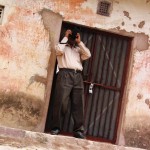Ajanta
The Rock cut Caves of Ajanta
Government service does provide some unique pleasures and opportunities.I must thank the Election Commission of India which sent me as an election observer to Buldana (Maharashtra).
I saw the Lonar Crater, Aurangabad, Ajanta, Ellora and vast areas completely devastated by earth quakes.
Ajanta Caves
The rock cut caves of Ajanta and Ellora in Maharashtra represent the ultimate in this type of cave architecture.
The Ajanta caves are older of the two – being over 21 centuries old.
The Ellora caves are some 6 centuries younger.
Location
The Ajanta caves were discovered in 1819 by a group of British Officers of the Madras Army. The officers accidentally stumbled upon the caves hidden amongst dense vegetation and buried under debris.
After that, the Archeological Survey of India started excavations.
These caves are located in a thickly forested horseshoe shaped ravine in the Sahyadri hills, 3½ km from the village called Ajintha, about 105 kilometers from Aurangabad.
The Waghur river runs at the bottom of the ravine.
Period of Excavation
There are 30 excavated caves in Ajanta.Cave nos. 1 to 29 and Cave no. 15A (the last one was discovered in 1956, and is still not officially numbered).
They are located about 35 to 110 ft. above the level of the river.
The first Buddhist rock-cut cave monuments at Ajanta date from the 2nd and 1st centuries B.C.
During the Gupta period (5th and 6th centuries A.D.), many more richly decorated caves were added to the original group.
The excavations of the caves were done in two distinct phases.
The first phase is called the Hinayana phase (referring to the Lesser Vehicle tradition of Buddhism, the earlier phase, when Buddha was revered symbolically).
Actually, Hinayana – a derogative term for Sthaviravada – does not object to Buddha statues.
Cave nos. 9, 10, 12, 13, and 15A were excavated during this phase.
These excavations have enshrined the Buddha in the form of the stupa, or mound.
Cave no. 8 was for long thought to be a Hinayāna cave.
Now it is treated as a Mahayana cave.
The second phase of excavation began after three centuries.
This phase is called the Mahayana phase (referring to the Greater Vehicle tradition of Buddhism, which is less strict and encourages direct depiction of Buddha through paintings and carvings).
This phase is also called the Vakataka phase after the ruling dynasty of the house of the Vakatakas of the Vatsagulma branch.
None of the caves in the Vakataka phase were ever fully completedbecause the Vakataka dynasty suddenly fell out of power which brought the activities at Ajanta to a complete halt.
Two Types of Structures
The Ajanta caves consists of two types of excavations – viharas (monastic halls of residence) and chaitya grihas (stupa or monument halls).
Cave nos. 9, 10, 19, 26 and 29 are chaitya grihas.
The others are viharas.
The caves contain paintings and sculptures considered to be masterpieces of both Buddhist religious art and universal pictorial art.
There are paintings on the walls in Cave nos. 1, 2, 16 and 17 that are clear and vibrant even today.
All the paintings in the caves are linked to religion and centre around the Buddha.
They illustrate events in the life of Prince Gautama Buddha; incidents from the life of the Buddha; and the Jatakas (stories pertaining to Buddha’s previous incarnation).
Frescoes and murals
The paintings are often referred to as “frescoes”.
But the proper term for this kind of art work is “mural”, because the technique of fresco painting has not been used in Ajanta.
The technique used to produce the paintings at Ajanta is unique.
It is unlike any other artwork found in any other civilization.
The paintings give us a glimpse of the life style during that period – hair styles, ornaments, textiles, musical instruments, details of architecture, customs, etc.
It is difficult to believe that the beautiful caves and the carvings in the caves could have been chiselled out of granite rocks only with hammer and chisel.
The paintings were also done with very simple and basic material.
A particular type of classical Indian art started and developed in Ajanta.
This style traveled with Buddhism to many other countries – Sigiriya in Sri Lanka, Bamiyan in Afghanistan, Tibet, Nepal, China and Japan.
In 1983, the Ajanta Caves were declared a UNESCO World Heritage Site.
These are must see places for everyone.

nice blog good info
I bookmarked this site. Thank you for good job!
Incredible site!
Incredible site!
If you have to do it, you might as well do it right
……………………Great site………………………….